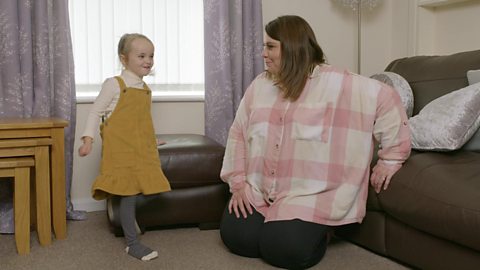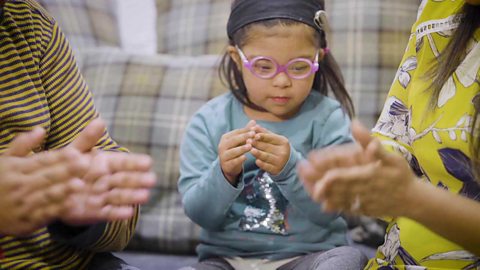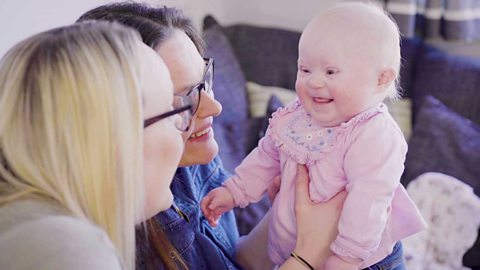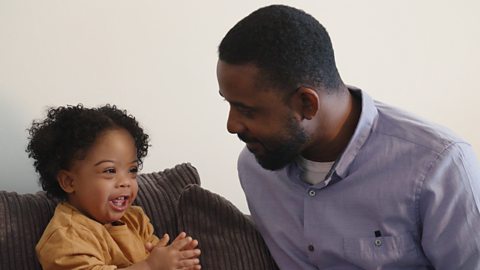Emma Fraser has worked in education for over 20 years as a teacher, Special Educational Needs Co-ordinator and Teacher of the Deaf. She now works for the National Deaf Children’s Society.
We spoke to her about how you can support your child's communication skills and language development if they are deaf.
Communication with your baby begins from birth, long before first words, with cries, then coos and smiles. Responding to your touch, making noises and copying your expressions when you come close are all early signs that your baby is communicating with you.
As they get older, children use their communication and language skills to make friends, bond with their family and make sense of their world.
Being deaf can make it more challenging for your child to access good communication and spoken language. But in most cases, there’s no reason why, with the right support and positive attitudes towards deafness, a deaf child can’t develop the same language and communication skills as any other child.
As a parent there are lots of ways you can support your children’s language development and help to create a deaf-friendly environment for your child.
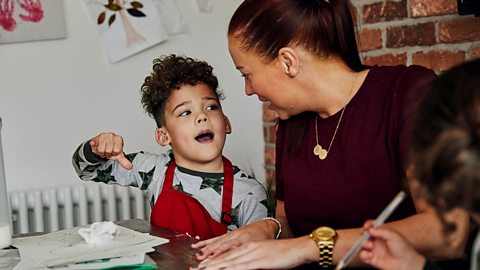
Different ways to communicate with deaf children
Your child may use hearing aids or cochlear implants to help them hear and learn spoken language. They may also use signs, natural gestures and lip-reading as well.
Sign language is a visual language that uses hand shapes, facial expressions, gestures, and body language.
In Britain, the term sign language usually refers to . It’s a complete language with its own vocabulary, construction, and grammar. Other sign systems, such as Signed English or , also use the signs from BSL, but follow the structure of spoken English and are used alongside it.
It's really important to use lots of visual information, such as showing your child what you’re talking about and making sure they can see your face when you talk.
Making your voice and face interesting by being expressive when you speak will also help to get your child interested in language.
If your child needs to hear you to communicate, it’s important to think about their listening environment. By closing doors, turning off the TV, getting closer to them and asking others to talk one at a time, your child will have a greater chance of hearing and seeing everything you say.
Learning some signs with your family is also lots of fun and a great way to communicate and bond with your child. Some people believe that learning sign language can delay or stop a child from learning to speak, but there’s no evidence to support this.
Find out more about different ways of communicating with babies using sign, pictures and objects.
You will know what works best for your child and your family.
Bonding and communicating with deaf babies (12 months or below)
Your baby loves to spend time with you, being held, rocked in time to music, seeing your face and listening to your voice.
It doesn’t matter which language you use, whether spoken or signed, your baby will be responding to and learning from you.
Here are some things you can do:
- Use touch and sight as well as your voice to calm your baby, so they know you’re there. See if they quieten when you touch their tummy or see your smiling face.
- Sing songs and move your baby in time with your voice. This will help them learn about the rhythm and pace of speech. When your voice is high, swoop them up into the air and when it’s low, drop them down.
- Copy your baby’s sounds or expressions and wait for them to respond before doing it again. Turn-taking is an important part of learning to communicate.
- Touch your child before you start to talk or sign, and make sure they can see you. Comment on whatever they‚Äôre looking at: ‚ÄúThere‚Äôs a sleepy cat. He‚Äôs tired.‚ÄĚ
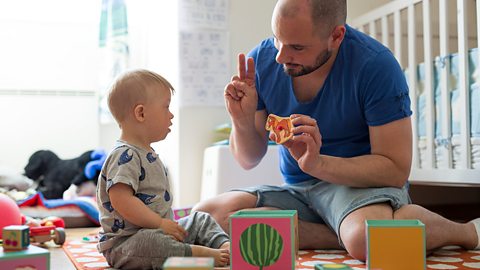
Helping deaf toddlers with their language
As your baby grows, they will begin to use the communication and language they’ve seen and heard. All children develop at their own pace, so don’t worry if they take a little longer to show you what they know.
Here are some ideas of things that you can do:
- Put actions to songs and make up silly rhymes. Rhyme, rhythm, and repetition are great ways to build language skills in a fun way and they help your child tune into the way language looks and sounds.
- Repeat back and add in extra information about what your child is looking at and commenting on: ‚ÄúShoes‚Ķ yes, they‚Äôre your wellies. Now you can jump in puddles.‚ÄĚ Repeating and extending your child‚Äôs language is a great way of linking new learning to familiar language.
- Use open ended questions like: ‚ÄúWhat‚Äôs that?‚ÄĚ and ‚ÄúWhere are we going?‚ÄĚ. Allow time for your child to think about what they‚Äôre going to say and how they‚Äôll say it. Deaf children may need extra processing time when using spoken language.
- Use language about thinking and feeling, such as ‚ÄúI wonder‚ÄĚ, ‚ÄúWhat do you think?‚ÄĚ and ‚ÄúHow do you feel?‚ÄĚ. Tell your child what you‚Äôre thinking and feeling too. This helps them to label their emotions and understand that different people know, feel, and think different things to them. It also makes it easier to form new friends and relationships with people who don‚Äôt know them.
- Give your child the vocabulary they need to talk about their deafness and let others know how best to communicate with them.
There are lots of activities that can help your child with their communication and language on the Tiny Happy People activities pages.
What to remember when communicating with a deaf child
There are some simple things you can to really help your child communicate if they are deaf or hard of hearing:
- Be expressive and use your whole body to communicate, from your lip patterns through to your body language.
- Check your child’s communication environment and make sure they can see and hear as much language as possible by getting down to their level and getting their attention before you speak or sign to them.
- Create a rich language environment. Comment on what your child is interested in, ask questions, talk about thinking and label feelings.
- Don’t be afraid to use new words and signs.

If you suspect your child has a hearing loss, contact the audiology department at your local hospital and request a hearing check, or speak to your GP.
Signs of hearing loss in young children could include:
- Not being startled by loud sounds or turning toward sound
- Mishearing and mispronouncing words.
- Struggling to hear and join in if the environment is noisy, watching faces intently or waiting to see what others do before joining in.
- Delayed or non-developing language.
- Difficulties with early literacy skills.
- Speaking too loudly or too softly.
Where to find help
If your child has recently been identified as deaf, or you just want to find out more about deafness, the National Deaf Children’s Society provides information, advice and events for families.
They also provide links to local groups, where you can meet the families of other deaf children.
For advice or support, call the charity’s free Helpline on 0808 800 8880. For more information, visit the charity’s website at .

